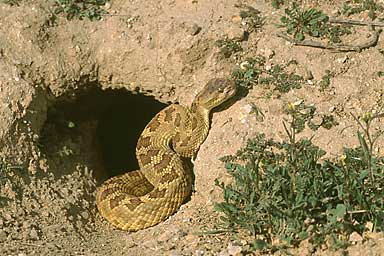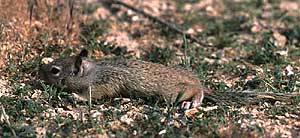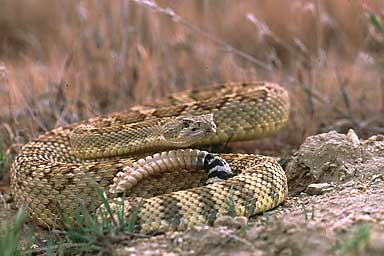|
Plain and Desert, April 2000 | |||
| |||
|
The Carrizo Plain Food Chain | |||
| (Click any photo throughout to see a larger version) | |||
| We noticed one of the little ground squirrels off the side of the dirt road was considering scooting into a hole but seemed confused by the idea. It would almost go down, then stop and circle the perimeter as if unsure. As we rolled a few feet further we saw the reason for the squirrel's tentativeness poised a few feet away. I took this picture from the car window: | |||

|
|||
| We stopped the car and got out to get a better look at our new rattlesnake acquaintance, but it had chosen to vanish in the meantime. We then noticed the squirrel a few feet away, strangely splayed and still. | |||

|
|||
|
At first we thought the rattlesnake had bitten the squirrel, and that the squirrel was
spending its last moments in a state of shock. But it wasn't twitching or convulsing. Then
we saw another nearby squirrel doing exactly the same thing. Our best guess now is that it
was employing a defense mechanism to avoid the snake's attentions. A few moments later we
saw this squirrel race away, so it had suffered at most only psychological harm from this
serpentine encounter.
In the next quarter-mile of road we spotted two more rattlesnakes on the surface. Both of them put on half-hearted defensive coiling-and-rattling displays while they looked around for their favorite squirrel burrow to slither into. It was clear that these snakes had no interest in attacking people; they just wanted to look for a yummy ground squirrel dinner in the waning afternoon sun. | |||

|
|||
|
This charming fellow is displaying a magnificent 14-segment rattle. I have read that
rattles with more than 10 segments on any wild rattlesnakes are exceptional.
For the next few days we were convinced that our rattlers had been Mojave rattlesnakes (Crotalus scutulatus) -- the most venomous and aggressive rattlesnakes on the continent -- based primarily on their color. When I returned home I pored through all my snake references to determine that we had not been so lucky; they had been the far more common western rattlesnake (Crotalus viridis). But no matter, all three were big beautifully colored specimens that we were grateful to encounter. A little further down the road, Monica noticed yet another interesting critter watching us go by. It was a badger! | |||

|
|||
| This badger sat up on its haunches at the entrance of its burrow and stared at us for the ten or fifteen minutes that we admired and photographed it. Badgers have a nasty reputation, but this one was just unbelievably cute. How could anything so cute be mean? Rattlesnakes are among their favorite foods, and they are immune to rattlesnake venom. With the rattlesnake density we had observed, this badger was no doubt content with life. | |||
Next: On to the desert |


